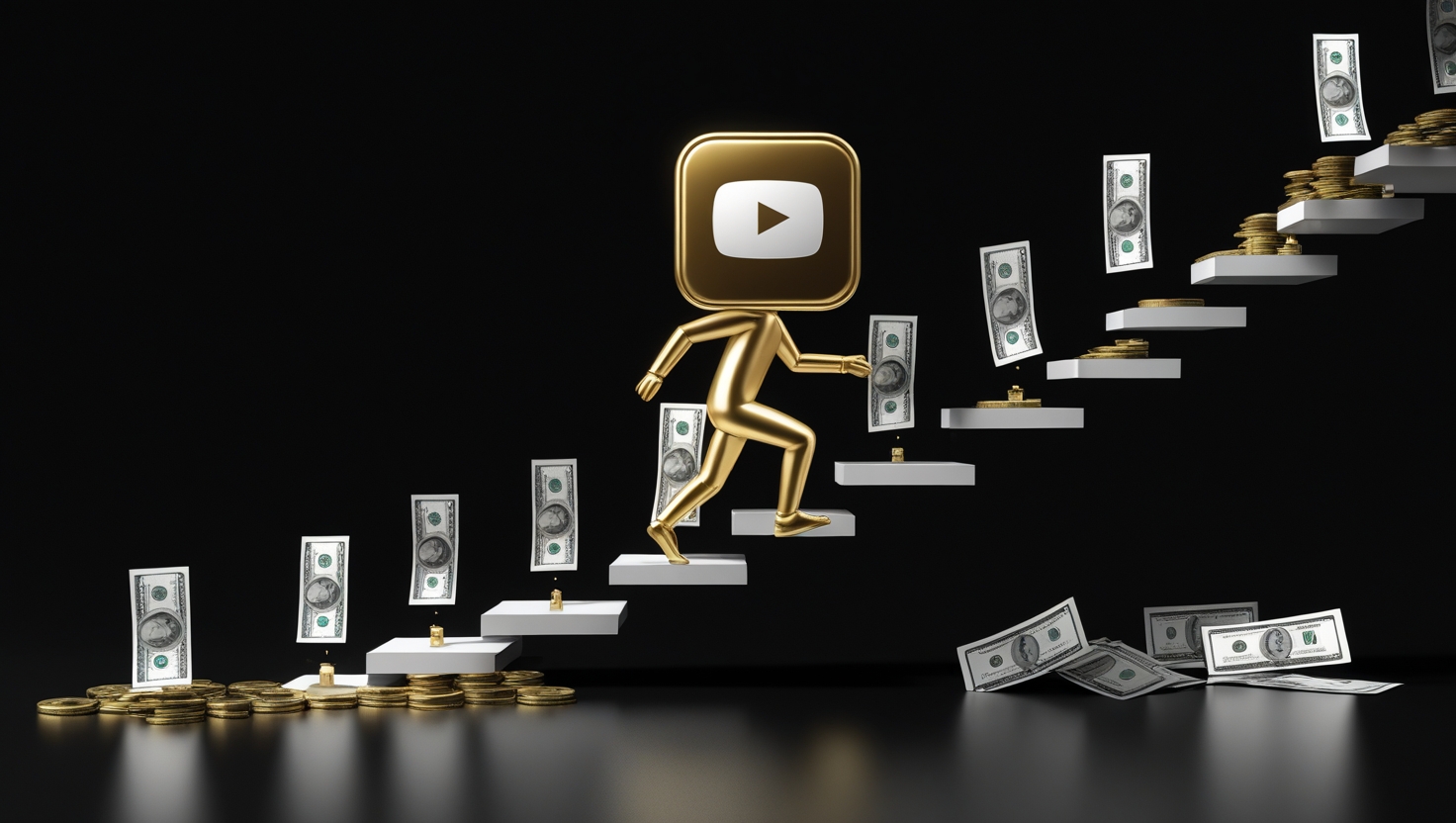Have you ever wondered how many subscribers on YouTube are really enough to start earning real money? Many aspiring creators get caught up in the idea that structure is entirely dependent on the number of subscribers alone. In reality, while reaching that 1,000-subscriber threshold is the first step for unlocking monetization, the correlation between subscribers and revenue is much more nuanced. In this article, we’ll dive into the minimum requirements for YouTube’s monetization, the additional factors that influence income, and share real-life examples to illustrate the diversity in channel performance, making your journey both practical and promising.
If you’re new to the world of YouTube monetization, you might want to check out our detailed guide on how YouTube earns money for more insights. For additional information, you can also visit the official support page on monetization by Google’s YouTube Support.

Subscriber Requirements for YouTube Income
The rule of thumb is that you need to have a minimum of 1,000 subscribers and 4,000 valid public watch hours in the past 12 months to be eligible for the YouTube Partner Program. Don’t get fooled into thinking that high subscriber counts only mean high earnings. That initial milestone is where it begins. Numerous creators had once been bowled over by the figures but established that enduring effort and exciting content are of more importance than the subscriber figures themselves.
This 1,000-subscriber benchmark is not arbitrary. It’s a quality threshold that ensures creators have started to build a community of engaged viewers. This number of 1,000 may appear trivial compared to channels with 10,000 or 1 million subscribers, but keep in mind that upfront monetization potential rests on quality content, viewer dedication, and niche interest. The threshold, essentially, is a portal to more diverse sources of income.
1000 Subscribers YouTube Monetization and Beyond – How Many Subscribers؟
The moment you hit 1,000 subscribers, your channel becomes eligible for monetization through YouTube’s ad programs. This milestone is exciting, but it doesn’t necessarily guarantee substantial earnings right away. Even with the 1K mark, several factors come into play such as video views, viewer demographics, and the overall engagement rate. From sponsored content and affiliate marketing to merchandise and external platforms like Patreon, revenue streams diversify once the channel is recognized as a trusted brand.
Are you curious about why some channels with relatively fewer subscribers generate considerable income? The answer lies in different metrics, with cost per mille (CPM) being a primary financial determinant. CPM rates can vary dramatically based on niche, content type, and seasonal trends. For example, niches like finance, tech, or education can attract higher CPMs due to the competitiveness of related advertising sectors.
Factors Determining YouTube Revenue Beyond Subscriber Count
While subscriber count is a fundamental aspect of monetization, several intertwined variables affect the income potential. Let’s break down some key influences:
Content Quality and Niche Specificity: A channel that produces highly engaging, targeted content in a lucrative niche may outperform larger channels with less focused strategies. High-quality videos that solve problems or provide unique entertainment can attract premium advertisers.
Viewer Engagement: Engagement metrics such as likes, comments, shares, and watch time also influence earnings. YouTube’s algorithm rewards channels that maintain high viewer retention and interactive communities. So, even if you’re starting with around 1,000 subscribers, active viewers who comment and share your videos can significantly boost your revenue potential.
Monetization Methods: Diversification beyond ad revenue plays a critical role. Channels often combine ad revenue with sponsored content, affiliate marketing, merchandise, and memberships on platforms like Patreon. This means that a creator with 1,000 engaged subscribers might earn money faster than someone with a larger but less committed audience.
CPM and Ad Placements: CPM can vary from a few dollars to over $20 per thousand views, dramatically impacting your income. Factors such as the geographical location of your audience, time of year, and even current events can shift CPM values. Hence, focusing solely on subscriber count without optimizing these parameters may limit your earning potential.
Real-Life Examples: Channels at Different Subscriber Milestones
Let’s now consider some real-world examples. Imagine three channels with differing subscriber bases:
| Channel Type | Subscriber Count | Primary Revenue Factors |
|---|---|---|
| Emerging Channel | ~1,000 Subscribers | Ad revenue from niche content, high CPM due to targeted audience, early sponsorship opportunities |
| Growing Channel | ~10,000 Subscribers | Increased ad revenue, diversified income streams including affiliate marketing and merchandise |
| Mature Channel | ~1,000,000 Subscribers | Multiple revenue streams such as high-volume ad impressions, brand deals, direct fan support platforms, and merchandising |
These examples underline that while starting with 1,000 subscribers is a key milestone, the true growth in earnings is driven by how effectively you can engage your audience and diversify your income streams. Ask yourself, “How can I increase not just the number of subscribers but also the quality of my audience?” This reflection can lead you to more creative strategies beyond immediately chasing huge subscriber numbers.
Strategies for Increasing Active and Loyal Subscribers
Building a successful YouTube channel is so much more than getting a huge number. It’s building a dedicated, engaged following. Here are some hard-hitting, real-world, no-nonsense strategies backed up by both success stories on the ground and anecdotal evidence:
First, attempt making content that directly addresses your audience’s wants or needs. When content is relevant and tailored, the audience will simply be more inclined to engage, share, and subscribe. This community focus begins at the micro level—a conversation, not a broadcast. Engage your audience by asking simple questions in your videos, such as “Have you ever experienced this dilemma?
” or “What do you think about this trend?
” This kind of interaction can significantly boost the sense of community and loyalty among viewers.
Second, use cross-promotion between platforms. Social media platforms, websites, and even podcasts can send new viewers to your YouTube channel. Cross-promotion is good for the subscriber base but also gets you in front of a wider audience, creating more robust engagement. Using an informal tone and providing behind-the-scenes details can also make your brand less mysterious and you a distinct alternative. In addition, consider using analytics to know what viewers do. By looking at watch time, engagement rates, and demographic information, you can refine your content strategy to better serve the tastes of your audience. Remember always: quality trumps quantity. It is more desirable to have a small, active audience than a large, inactive one. Lastly, never underestimate the strength of consistency. Regular uploads, branding, and a well-organized content calendar retain the audience’s interest and foster long-term loyalty. Regular engagement in the shape of community posts, live sessions, or Q&A sessions can initiate organic growth and significantly enhance revenue potential.
Tips for Diversifying Your Income Streams on YouTube
While reaching the minimum subscriber count opens the door to basic monetization, the true power lies in exploring various revenue streams. Consider incorporating these strategies into your growth plan:
Sponsorships and Brand Deals: Once you establish a niche-focused channel with consistent engagement, brands may approach you for sponsored content. These partnerships often provide a more lucrative and steady income than ad revenue alone.
Affiliate Marketing: Aligning with products or services that match your audience’s interests can result in substantial commissions. By embedding affiliate links in your video descriptions or even mentioning them in the video, you facilitate an additional revenue channel.
Merchandising and Fan Support: If your brand resonates well, consider launching merchandise or using platforms like Patreon. This not only increases income but also deepens the bond with your fans as they become invested in your journey.
Optimizing Video Content for Higher CPM: Focus on producing content that attracts viewers from high-value markets. Sometimes niche content that caters to specialized audiences can yield higher CPM values even if overall view counts are modest.
Analyzing the Relationship Between Subscribers and Income
It might seem logical to correlate higher subscriber counts with increased income. However, many factors create a complex relationship between subscribers and monetization. For instance, a channel with 50,000 highly engaged subscribers might generate more revenue than a channel with 500,000 passive subscribers. Engagement rate, watch time, video quality, content relevance, seasonality, and CPM all play vital roles.
When you look at these factors through a practical lens, you start to see that success on YouTube is multifaceted. It’s not just about reaching a numerical milestone for monetization; it’s about nurturing a community that believes in your vision and is motivated to interact with your content. Over time, as you expand your reach and diversify your income strategies, the subscriber count becomes one of many metrics to consider rather than the sole focus.

Concluding Thoughts: Your Roadmap to YouTube Success
To wrap things up, while hitting the 1,000-subscriber mark is a non-negotiable milestone that unlocks YouTube monetization, the overall revenue potential is tied to far more than just the number of subscribers. High-quality content, targeted niche marketing, robust engagement, and diversified income streams are key drivers for financial success. Whether your channel is just starting out or rapidly growing, focusing on building a loyal community can significantly enhance not only your YouTube earnings but also your overall impact in the digital landscape.
Think about your current strategies and ask yourself, “Am I engaging my audience in a way that fosters long-term loyalty?” Reflect on these best practices and continuously experiment with innovative ways to connect with your viewers. Your journey to success on YouTube might start with 1,000 subscribers, but it’s the relationship you build with your audience that will eventually determine your ultimate earnings.
For more insights on monetization strategies and comprehensive guides to earn money through YouTube, do check out our detailed post on how YouTube earns money. The digital world is vast and ever-evolving, and staying updated with trusted sources can give you the competitive edge you need.
Is there a direct correlation between the number of subscribers and ad revenue?
Not exactly. While more subscribers can lead to more views, active engagement and content quality often play an even greater role in determining overall revenue. A channel with fewer but highly engaged subscribers might outperform a larger channel where the viewer interaction is minimal.
What are some effective strategies to increase active and loyal subscribers?
Engaging content that speaks directly to your target audience, regular interaction through community posts or live streaming, and cross-platform promotion are all effective ways to increase subscribers. Focusing on quality over quantity goes a long way in building a dedicated viewer base.
How does CPM affect my YouTube earnings?
CPM, or cost per mille, influences the amount you earn per thousand ad impressions. It varies based on factors like geographic location, niche, and even seasonal trends. Higher CPM rates in specialized niches can sometimes mean that smaller channels with highly engaged viewers generate substantial revenue.
